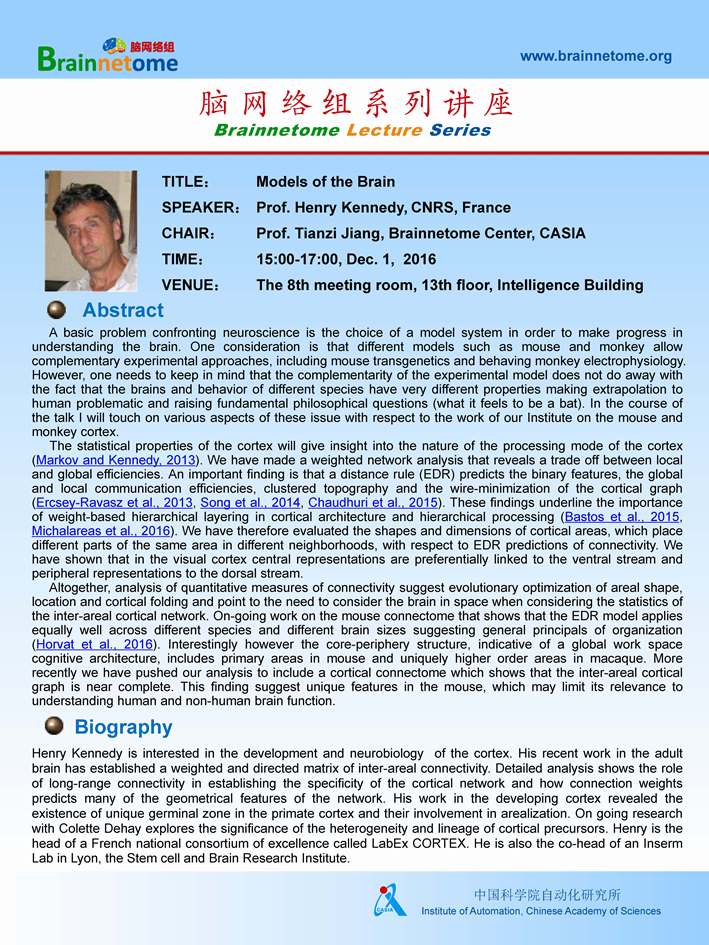Prof. Henry Kennedy's Lecture: Models of the Brain
Title: Models of the Brain
Speaker: Prof. Henry Kennedy, CNRS, France
Chair: Prof. Tianzi Jiang, Brainnetome Center, CASIA
Time: 15:00-17:00 Dec. 1, 2016
Venue: The 8th meeting room, 17th floor of the Intelligence Building
[Abstract]
A basic problem confronting neuroscience is the choice of a model system in order to make progress in understanding the brain. One consideration is that different models such as mouse and monkey allow complementary experimental approaches, including mouse transgenetics and behaving monkey electrophysiology. However, one needs to keep in mind that the complementarity of the experimental model does not do away with the fact that the brains and behavior of different species have very different properties making extrapolation to human problematic and raising fundamental philosophical questions (what it feels to be a bat). In the course of the talk I will touch on various aspects of these issue with respect to the work of our Institute on the mouse and monkey cortex.
The statistical properties of the cortex will give insight into the nature of the processing mode of the cortex (Markov and Kennedy, 2013). We have made a weighted network analysis that reveals a trade off between local and global efficiencies. An important finding is that a distance rule (EDR) predicts the binary features, the global and local communication efficiencies, clustered topography and the wire-minimization of the cortical graph (Ercsey-Ravasz et al., 2013, Song et al., 2014, Chaudhuri et al., 2015). These findings underline the importance of weight-based hierarchical layering in cortical architecture and hierarchical processing (Bastos et al., 2015, Michalareas et al., 2016). We have therefore evaluated the shapes and dimensions of cortical areas, which place different parts of the same area in different neighborhoods, with respect to EDR predictions of connectivity. We have shown that in the visual cortex central representations are preferentially linked to the ventral stream and peripheral representations to the dorsal stream.
Altogether, analysis of quantitative measures of connectivity suggest evolutionary optimization of areal shape, location and cortical folding and point to the need to consider the brain in space when considering the statistics of the inter-areal cortical network. On-going work on the mouse connectome that shows that the EDR model applies equally well across different species and different brain sizes suggesting general principals of organization (Horvat et al., 2016). Interestingly however the core-periphery structure, indicative of a global work space cognitive architecture, includes primary areas in mouse and uniquely higher order areas in macaque. More recently we have pushed our analysis to include a cortical connectome which shows that the inter-areal cortical graph is near complete. This finding suggest unique features in the mouse, which may limit its relevance to understanding human and non-human brain function.
[Biography]
Henry Kennedy is interested in the development and neurobiology of the cortex. His recent work in the adult brain has established a weighted and directed matrix of inter-areal connectivity. Detailed analysis shows the role of long-range connectivity in establishing the specificity of the cortical network and how connection weights predicts many of the geometrical features of the network. His work in the developing cortex revealed the existence of unique germinal zone in the primate cortex and their involvement in arealization. On going research with Colette Dehay explores the significance of the heterogeneity and lineage of cortical precursors. Henry is the head of a French national consortium of excellence called LabEx CORTEX. He is also the co-head of an Inserm Lab in Lyon, the Stem cell and Brain Research Institute.

